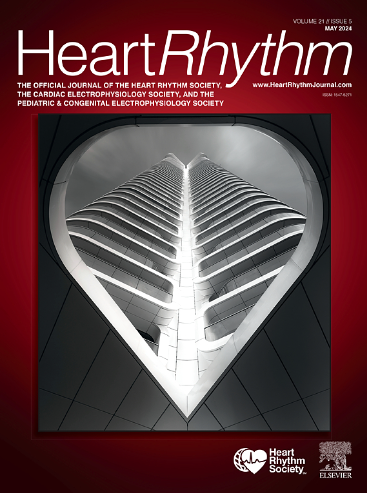Sleep-disordered breathing destabilizes ventricular repolarization: Cross-sectional, longitudinal, and experimental evidence
IF 5.6
2区 医学
Q1 CARDIAC & CARDIOVASCULAR SYSTEMS
引用次数: 0
Abstract
Background
Sleep-disordered breathing (SDB) increases the risk of cardiac arrhythmias and sudden cardiac death.
Objective
This study sought to characterize the associations between SDB, intermittent hypoxemia, and the beat-to-beat QT variability index (QTVI), a measure of ventricular repolarization lability associated with cardiac arrhythmias and sudden cardiac death.
Methods
Three distinct cohorts were used: a matched sample of 122 participants with and without severe SDB for cross-sectional analysis; a matched sample of 52 participants with and without incident SDB for longitudinal analysis; and a sample of 19 healthy adults exposed to acute intermittent hypoxia and ambient air on 2 separate days. The cross-sectional and longitudinal cohorts were the Sleep Heart Health Study participants with no known comorbidities who were not taking any drugs known to affect cardiac repolarization and satisfied the inclusion criteria. Electrocardiographic measures were calculated from 1-lead electrocardiograms.
Results
Participants with severe SDB had greater QTVI than those without SDB (P = .027). Total sleep time with <90% oxygen saturation, but not the arousal frequency, was a predictor of QTVI. QTVI during sleep was predictive of all-cause mortality. With incident SDB, mean QTVI increased from −1.23 to −0.86 during 5 years (P = .017). Finally, experimental exposure of healthy adults to acute intermittent hypoxia for 4 hours progressively increased QTVI (P = .016).
Conclusion
The results show that both prevalent SDB and incident SDB are associated with ventricular repolarization instability and suggest intermittent hypoxemia as the underlying mechanism that may contribute to increased mortality in SDB.
睡眠呼吸障碍会破坏心室复极稳定:横断面、纵向和实验证据 - 间歇性低氧血症的作用。
背景:睡眠呼吸障碍(SDB)会增加心律失常和心脏性猝死的风险:睡眠呼吸障碍(SDB)会增加心律失常和心脏性猝死的风险:目的:描述睡眠呼吸障碍、间歇性低氧血症与每搏QT变异指数(QTVI)之间的关系,QTVI是衡量与心律失常和心脏性猝死相关的心室复极化不稳定性的指标:使用了三个不同的队列:(1) 122 名患有和未患有严重 SDB 的参与者的匹配样本,用于横断面分析;(2) 52 名患有和未患有 SDB 的参与者的匹配样本,用于纵向分析;(3) 19 名健康成人的样本,分别在两天内暴露于急性间歇性缺氧和环境空气中。横向和纵向样本均为睡眠心脏健康研究的参与者,他们没有已知的合并症,没有服用任何已知会影响心脏复极化的药物,并且符合纳入标准。心电图测量结果由单导联心电图计算得出:严重 SDB 患者的 QTVI 比非 SDB 患者高(P = 0.027)。血氧饱和度低于 90% 的总睡眠时间是 QTVI 的预测因素,但唤醒频率不是。睡眠中的 QTVI 可预测全因死亡率。如果发生 SDB,平均 QTVI 在 5 年内会从-1.23 增加到-0.86(P = 0.017)。最后,在实验中将健康成年人暴露于急性间歇性缺氧环境中 4 小时,QTVI 会逐渐升高(P = 0.016):结论:研究结果表明,流行性和偶发性 SDB 均与心室再极化不稳定有关,并提示间歇性低氧血症是可能导致 SDB 死亡率增加的潜在机制。
本文章由计算机程序翻译,如有差异,请以英文原文为准。
求助全文
约1分钟内获得全文
求助全文
来源期刊

Heart rhythm
医学-心血管系统
CiteScore
10.50
自引率
5.50%
发文量
1465
审稿时长
24 days
期刊介绍:
HeartRhythm, the official Journal of the Heart Rhythm Society and the Cardiac Electrophysiology Society, is a unique journal for fundamental discovery and clinical applicability.
HeartRhythm integrates the entire cardiac electrophysiology (EP) community from basic and clinical academic researchers, private practitioners, engineers, allied professionals, industry, and trainees, all of whom are vital and interdependent members of our EP community.
The Heart Rhythm Society is the international leader in science, education, and advocacy for cardiac arrhythmia professionals and patients, and the primary information resource on heart rhythm disorders. Its mission is to improve the care of patients by promoting research, education, and optimal health care policies and standards.
 求助内容:
求助内容: 应助结果提醒方式:
应助结果提醒方式:


